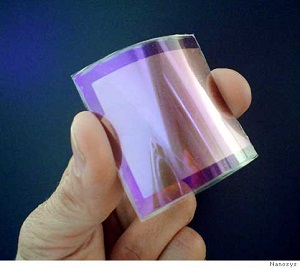Thin-film PV efficiencies gaining
 Thin-film photovoltaics are beginning to catch up with their silicon-based PV cousins in terms of converting sunlight radiation into electricity. For instance, the Energy Information Administration (EIA) reported that in 2008 that crystalline silicon was 19 percent efficient at converting sunlight into electricity, while thin-film technologies were between 8 percent and 12 percent efficient at converting sunlight to electricity. While that might seem like a big difference, in terms of pricing, thin-film already is cost competitive with silicon, because less materials are needed, and the manufacturing costs are lower. But as efficiency of thin-film PV increases, it is likely to overtake silicon as the most popular manufacturing technologies for PV.
Thin-film photovoltaics are beginning to catch up with their silicon-based PV cousins in terms of converting sunlight radiation into electricity. For instance, the Energy Information Administration (EIA) reported that in 2008 that crystalline silicon was 19 percent efficient at converting sunlight into electricity, while thin-film technologies were between 8 percent and 12 percent efficient at converting sunlight to electricity. While that might seem like a big difference, in terms of pricing, thin-film already is cost competitive with silicon, because less materials are needed, and the manufacturing costs are lower. But as efficiency of thin-film PV increases, it is likely to overtake silicon as the most popular manufacturing technologies for PV.
Case-in-point, Belgian nanotechnology company Imec recently reported that it is able to produce large-scale PV cells 70 square centimeters (larger than 2 square feet) that are 16.3 percent efficient. The company said it achieved the results high-quality substrates, but added that on lower-quality substrates, it still was able to produce 14.7 percent efficiencies. Imec’s silicon solar cell industrial affiliation program (IIAP) created the cells. The importance of such advances are ultimately lowered cost with increased efficiency, as well as products that need less energy to be produced.
“These efficiencies…show that industrial-level efficiencies are within reach for this technology.” contended Jef Poortmans, director imec energy/solar program. “By implementing copper-based contact schemes, we can further increase the efficiency, making epitaxial thin-film silicon solar cells on low-cost wafers an interesting industrial technology.”
Higher efficiencies of thin-film PV have been reached. In 2008, the National Renewable Energy Laboratory said copper indium gallium diselenide thin-film PVs reached 19.9 percent efficiencies, while silicon-based solar cells have shown efficiencies as high as 20.3 percent. And one company RSLEnergy said its thin-film, multi-band PV technology could trump the nearly 20 percent efficiency within the next few years by reaching efficiencies of up to 35 percent.



